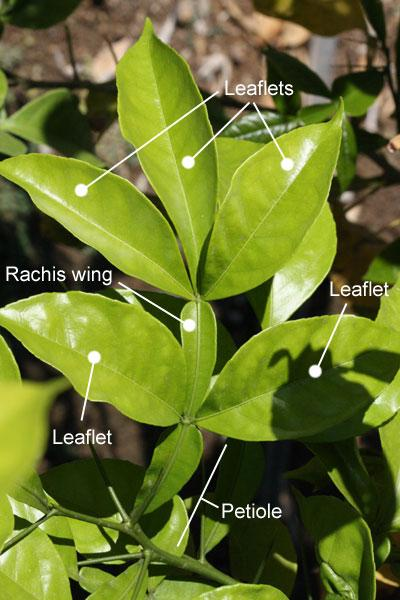
Petiole is winged in-
(a) Citrus
(b) Pea leaf
(c) Dionaea leaf
(d) Both A and C
Answer
510.6k+ views
Hint: Petiole is the stalk that attaches the leaf blade to the stem and can twist the leaf to face the sun when required, to facilitate in their process of food making, that is, photosynthesis.
Complete answer: Winged petiole is the one in which there is a thin flange of tissue along the length of the petiole. It is a green and flattened petiole. Plants like Citrus and Dionaea have winged petiole in them.
This also gives a characteristic foliage arrangement to the plant. Outgrowth present on each side of the petiole in some species is called stipules. Leaves that do not have petiole are called sessile or apetiolate.
Additional Information:
1. Plants with compound leaves have their leaflets attached to a continuation in the petiole. This is called the rachis. Each leaflet may be attached to the rachis by a short stalk which is called a petiole.
2. Swollen regions may be present at either end of the petiole and this is known as pulvina. These are composed of flexible tissue and allow leaf movement. Pulvina is commonly seen in the bean family- Fabaceae and the prayer plant family- Marantaceae.
3. In some plants, the petioles are flattened and widened so as to become phyllodes or cladophylls, and here the true leaves may be reduced or absent. Thus, the phyllode itself serves the functions of the leaf. Phyllodes are commonly seen in genus Acacia, especially the Australian species.
So, the correct answer is ‘Both A and C'.
Note: Leaves are responsible for fueling plants through photosynthesis and the petiole serves to transport the energy made in the leaf to rest all parts of the plant.
It also serves to transport nutrients and water which are absorbed by the roots and passed up through the xylem, to the leaf.

Complete answer: Winged petiole is the one in which there is a thin flange of tissue along the length of the petiole. It is a green and flattened petiole. Plants like Citrus and Dionaea have winged petiole in them.
This also gives a characteristic foliage arrangement to the plant. Outgrowth present on each side of the petiole in some species is called stipules. Leaves that do not have petiole are called sessile or apetiolate.
Additional Information:
1. Plants with compound leaves have their leaflets attached to a continuation in the petiole. This is called the rachis. Each leaflet may be attached to the rachis by a short stalk which is called a petiole.
2. Swollen regions may be present at either end of the petiole and this is known as pulvina. These are composed of flexible tissue and allow leaf movement. Pulvina is commonly seen in the bean family- Fabaceae and the prayer plant family- Marantaceae.
3. In some plants, the petioles are flattened and widened so as to become phyllodes or cladophylls, and here the true leaves may be reduced or absent. Thus, the phyllode itself serves the functions of the leaf. Phyllodes are commonly seen in genus Acacia, especially the Australian species.
So, the correct answer is ‘Both A and C'.
Note: Leaves are responsible for fueling plants through photosynthesis and the petiole serves to transport the energy made in the leaf to rest all parts of the plant.
It also serves to transport nutrients and water which are absorbed by the roots and passed up through the xylem, to the leaf.

Recently Updated Pages
Master Class 12 Business Studies: Engaging Questions & Answers for Success

Master Class 12 English: Engaging Questions & Answers for Success

Master Class 12 Social Science: Engaging Questions & Answers for Success

Master Class 12 Chemistry: Engaging Questions & Answers for Success

Class 12 Question and Answer - Your Ultimate Solutions Guide

Master Class 11 Economics: Engaging Questions & Answers for Success

Trending doubts
Draw a labelled sketch of the human eye class 12 physics CBSE

a Tabulate the differences in the characteristics of class 12 chemistry CBSE

Which one of the following is a true fish A Jellyfish class 12 biology CBSE

Why is the cell called the structural and functional class 12 biology CBSE

Differentiate between homogeneous and heterogeneous class 12 chemistry CBSE

Write the difference between solid liquid and gas class 12 chemistry CBSE




